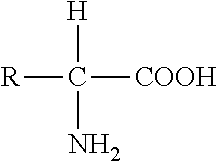Compositions and methods for identifying and diagnosing salt sensitivity of blood pressure
a technology of salt sensitivity and compositions, applied in the field of compositions and methods for identifying and diagnosing salt sensitivity of blood pressure, can solve problems such as a major public health problem, and achieve the effect of reducing the likelihood of salt-associated illnesses in individuals and increasing blood pressur
- Summary
- Abstract
- Description
- Claims
- Application Information
AI Technical Summary
Benefits of technology
Problems solved by technology
Method used
Image
Examples
embodiments
[0253]Past studies have demonstrated that single nucleotide polymorphisms (SNPs) of the sodium-bicarbonate co-transporter gene (SLC4A5) are associated with hypertension. The present application tested the hypothesis that SNPs in SLC4A5 are associated with salt sensitivity of blood pressure (BP). To that end, described herein are studies that were performed in 185 Caucasians consuming an isocaloric constant diet with a randomized order of 7 days low Na+ (10 mEq / d) and 7 days high Na+ (300 mEq / d) intake. Salt sensitivity was defined as a ≧7 mm Hg increase in mean arterial pressure (MAP) during a randomized transition between high and low Na+ diet.
[0254]Generally, salt sensitivity of blood pressure is a quantitative trait in which an increase in sodium (Na+) load leads to an increase in blood pressure (BP). In one aspect, salt sensitivity is about a ≧7 mm Hg increase in mean arterial pressure (MAP) during a randomized transition between high and low Na+ diet.
[0255]The subjects studied ...
example 1
Methods
Study Participants
[0385]The present analyses were restricted to subjects with genotype and BP data: 55 hypertensive and 130 normotensive Caucasian subjects from the University of Virginia (UVA) discovery cohort and 211 Caucasian hypertensive subjects for the replication cohort (HyperPATH).
Human Subjects Protocol (UVA Cohort)
[0386]The study protocol and informed consent documents were approved by the University of Virginia Institutional Review Board for Health Sciences Research. Tests for genetic association for BP traits were performed in 185 subjects of European ancestry ages 18-70 years and body mass index (BMI) of 18-30. The subjects were deemed healthy as determined by screening history, physical examination, standard 12-lead electrocardiogram, and laboratory testing (complete blood count, fasting comprehensive metabolic panel, lipid panel and urinalysis with microscopy). The subjects were classified either as normotensive (NT; BP500 mg / day, continuing active urinary sedi...
example 2
Increased BP on a Low Salt Diet—DRD2 SNP Rs6276
[0411]A small group of subjects were found to have an increase in BP on a low salt diet. When tested for associations, it was found unexpectedly that a SNP in the dopamine type 2 receptor—rs6276 (DRD2) showed a positive association: Odds Ratio (OR) of 2.6 and a p value ˜0.0008 in an adjusted model. DRD2 is on 11q22-q23. The NCBI Ref. Seq. No. is NC—000011.9 and it is 85,433 bp DNA.
[0412]There is currently no diagnostic test for these individuals who have a paradoxical increase in blood pressure on a low salt diet. The present invention therefore encompasses such a diagnostic test.
PUM
| Property | Measurement | Unit |
|---|---|---|
| pressure | aaaaa | aaaaa |
| pressure | aaaaa | aaaaa |
| blood pressure | aaaaa | aaaaa |
Abstract
Description
Claims
Application Information
 Login to View More
Login to View More - R&D
- Intellectual Property
- Life Sciences
- Materials
- Tech Scout
- Unparalleled Data Quality
- Higher Quality Content
- 60% Fewer Hallucinations
Browse by: Latest US Patents, China's latest patents, Technical Efficacy Thesaurus, Application Domain, Technology Topic, Popular Technical Reports.
© 2025 PatSnap. All rights reserved.Legal|Privacy policy|Modern Slavery Act Transparency Statement|Sitemap|About US| Contact US: help@patsnap.com

